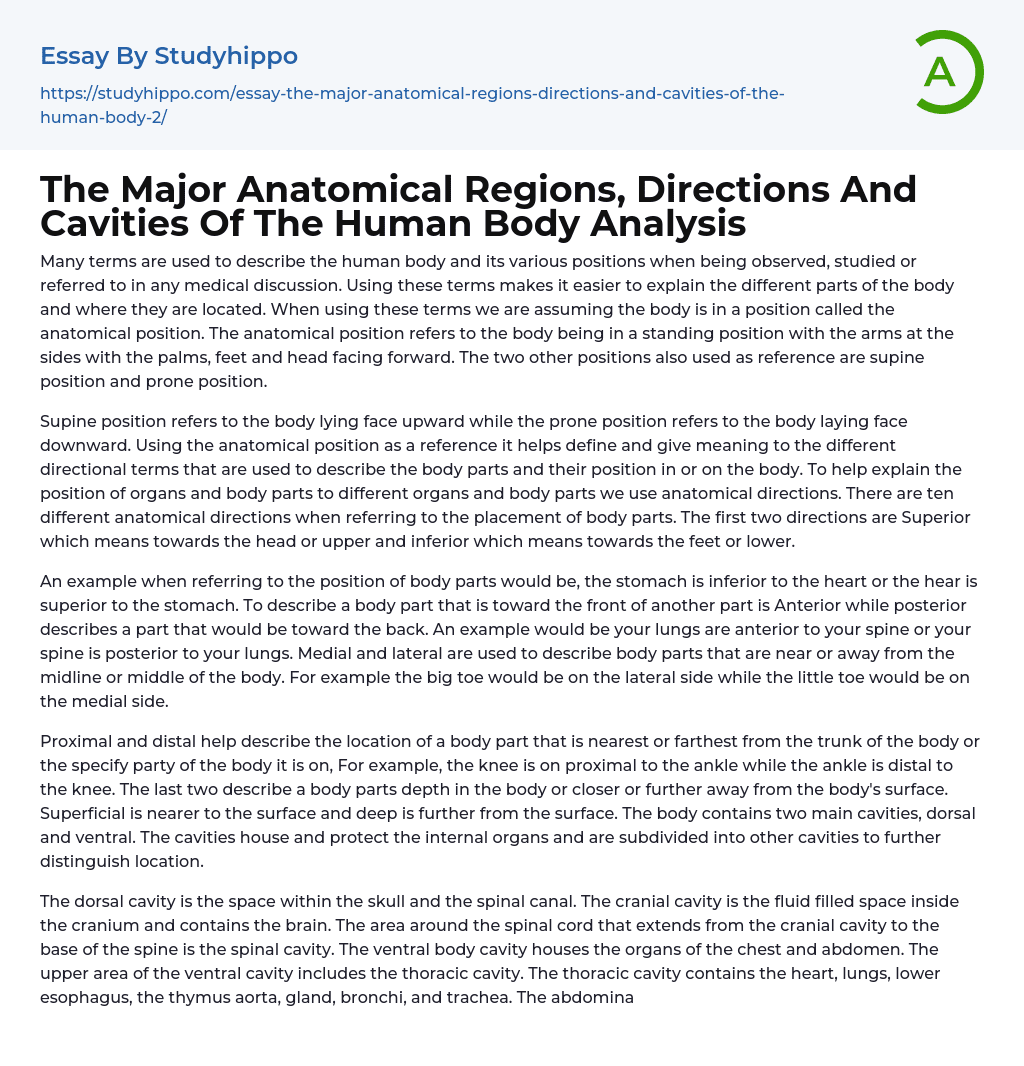

The Major Anatomical Regions, Directions And Cavities Of The Human Body Analysis Essay Example
Numerous terminology is employed to discuss the human body and its diverse positions in medical dialogues or studies. Utilizing these terms simplifies the process of detailing different body parts and their placement. It is assumed that these terms refer to the body when it's in the 'anatomical position.' This position suggests the body is standing with hands at the sides, palms, feet, and head directed forward. Two more key positions used for reference are the supine position and the prone position.
The 'Supine position' is a term referring to a body posture where the face is directed upwards, in contrast to the 'Prone position' which indicates a body posture where the face is pointed downwards. The standard benchmark for understanding different positional terms related to various parts of the human body or their location on it, is provided by the anatomica
...l position. Usually, ten distinct anatomical directions are deployed to explain how organs and other parts of the body are situated relative to each other. The first two directions, specifically 'Superior', indicating towards the head or upper portion of the body, and 'Inferior', pointing towards feet or lower part, have significant roles.
Discussing the human body's anatomy, it can be stated that the stomach is placed beneath the heart, or conversely, the heart sits above the stomach. The terms Anterior and Posterior are used to describe body parts facing forward and those located at the back respectively. This means that in relation to one another, lungs are anterior to the spine while conversely, spine is posterior to lungs. Moreover, Medial and Lateral are terminologies indicating proximity or distance of body parts from an individual's midline. For instance,
your big toe would be categorized as lateral whereas your little toe would fall under medial.
The terms proximal and distal are used to describe the location of a body part relative to the main body or a specific limb component. For example, compared to the ankle, the knee is nearer (proximal) to the center of the body while the ankle is comparatively further away (distal) from it in relation to the knee. These terminologies can also represent how deeply placed within or close to or distant from skin's surface a certain body part is. A superficial object lies closer to skin whereas something deep resides more internally. The structure of human anatomy includes two primary cavities known as dorsal and ventral which protect internal organs and are divided into additional sub-cavities for precise localization.
The dorsal cavity, located in the skull and spinal canal, is composed of the cranial and spinal cavities. The fluid-filled cranial cavity found within the cranium serves as a home for the brain, while the spinal cavity covers the spinal cord that extends from the cranial cavity to the base of the spine. Another significant part is the ventral body cavity which houses organs in both thoracic (chest) and abdominal regions. This includes subdivisions like thoracic cavity - an upper portion housing heart, lungs, lower esophagus, thymus aorta gland, bronchi and trachea; whereas abdominal cavity holds kidneys, stomach intestines gallbladder liver spleen pancreas and ureters.
The pelvic cavity is the location of several reproductive organs, the urinary bladder, parts of the large intestine and the rectum. There is no clear demarcation between this cavity and the abdominal cavity; rather they merge to form
a unified space. This specific area can be divided into nine separate sections, akin to a tic tac toe board with its center referred to as the umbilical region. Starting from top left corner and moving in a clockwise direction, we find these regions: right hypochondriac region, epigastric region, left hypochondriac region, left lumbar region, left iliac region, hypogastric region, right iliac region and concluding with the right lumbar region.



